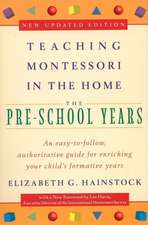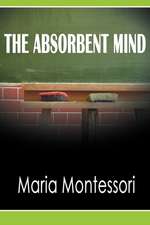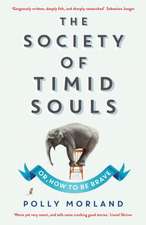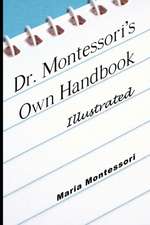The Montessori Method
Autor Maria Montessorien Limba Engleză Paperback – 21 feb 2008
Preț: 266.65 lei
Nou
Puncte Express: 400
Preț estimativ în valută:
51.02€ • 55.60$ • 42.99£
51.02€ • 55.60$ • 42.99£
Carte tipărită la comandă
Livrare economică 24 aprilie-08 mai
Preluare comenzi: 021 569.72.76
Specificații
ISBN-13: 9781408688311
ISBN-10: 140868831X
Pagini: 440
Dimensiuni: 140 x 216 x 25 mm
Greutate: 0.46 kg
Editura: Williams Press
ISBN-10: 140868831X
Pagini: 440
Dimensiuni: 140 x 216 x 25 mm
Greutate: 0.46 kg
Editura: Williams Press
Notă biografică
Maria Montessori è stata una pedagogista e medico italiano nota per il suo "Metodo Montessori". Nata nel 1870, ha condotto ricerche sulle tendenze naturali di apprendimento dei bambini e ha sviluppato una serie di strumenti educativi e materiali didattici per supportare queste tendenze. Il suo lavoro ha ispirato molte altre filosofie pedagogiche e ha contribuito a cambiare la percezione dell'educazione dei bambini. Montessori è morta nel 1952, ma il suo metodo continua a essere largamente utilizzato e rispettato in tutto il mondo.
Descriere
Descriere de la o altă ediție sau format:
This groundbreaking classic of educational philosophy takes on urgent new necessity today, as "traditional" methods of early-childhood schooling seem to be failing us. Published in Italian in 1909 and first translated into English in 1912, these still-revolutionary theories focus on the individuality of the child and on nurturing her inherent joy of learning to create schools and other learning environments that are oriented on the child. Eschewing rote memorization and drilling, Montessori's method helps to foster abstract thinking and to fulfill a child's highest potential, emotionally, physically and intellectually. Parents from all walks of life will find the ideas herein immensely valuable. Italian doctor and educator MARIA MONTESSORI (1870-1952) was the first woman to graduate from the University of Rome Medical School. She traveled extensively in Europe, America, and the Near East, studying early education and testing her educational methods.
This groundbreaking classic of educational philosophy takes on urgent new necessity today, as "traditional" methods of early-childhood schooling seem to be failing us. Published in Italian in 1909 and first translated into English in 1912, these still-revolutionary theories focus on the individuality of the child and on nurturing her inherent joy of learning to create schools and other learning environments that are oriented on the child. Eschewing rote memorization and drilling, Montessori's method helps to foster abstract thinking and to fulfill a child's highest potential, emotionally, physically and intellectually. Parents from all walks of life will find the ideas herein immensely valuable. Italian doctor and educator MARIA MONTESSORI (1870-1952) was the first woman to graduate from the University of Rome Medical School. She traveled extensively in Europe, America, and the Near East, studying early education and testing her educational methods.
Cuprins
INTRODUCTION TO THE TRANSACTION EDITION, INTRODUCTION. CHAPTER I A CRITICAL CONSIDERATION OF THE NEW PEDAGOGY IN ITS RELATION TO MODERN SCIENCE, CHAPTER II HISTORY OF METHODS, CHAPTER III INAUGURAL ADDRESS DELIVERED ON THE OCCASION OF THE OPENING OF ONE OF THE CHILDREN'S HOUSES, CHAPTER IV PEDAGOGICAL METHODS USED IN THE CHILDREN'S HOUSES, CHAPTER V DISCIPLINE, CHAPTER VI HOW THE LESSON SHOULD BE GIVEN, CHAPTER VII EXERCISES OF PRACTICAL LIFE, CHAPTER VIII REFECTION—THE CHILD'S DIET, CHAPTER IX MUSCULAR EDUCATION—GYMNASTICS, CHAPTER X NATURE IN EDUCATION—AGRICULTURAL LABOUR: CULTURE OF PLANTS AND ANIMALS, CHAPTER XI MANUAL LABOUR—THE POTTER'S ART, AND BUILDING, CHAPTER XII EDUCATION OF THE SENSES, CHAPTER XIII EDUCATION OF THE SENSES AND ILLUSTRATIONS OF THE DIDACTIC MATERIAL: GENERAL SENSIBILITY: THE TACTILE, THERMIC, BARIC AND STEREOGNOSTIC SENSES, CHAPTER XIV GENERAL NOTES ON THE EDUCATION OF THE SENSES, CHAPTER XV INTELLECTUAL EDUCATION, CHAPTER XVI METHOD FOR THE TEACHING OF READING AND WRITING, CHAPTER XVII DESCRIPTION OF THE METHOD AND DIDACTIC MATERIAL USED, CHAPTER XVIII LANGUAGE IN CHILDHOOD, CHAPTER XIX TEACHING OF NUMERATION: INTRODUCTION TO ARITHMETIC, CHAPTER XX SEQUENCE OF EXERCISES, CHAPTER XXI GENERAL REVIEW OF DISCIPLINE, CHAPTER XXII CONCLUSIONS AND IMPRESSIONS













